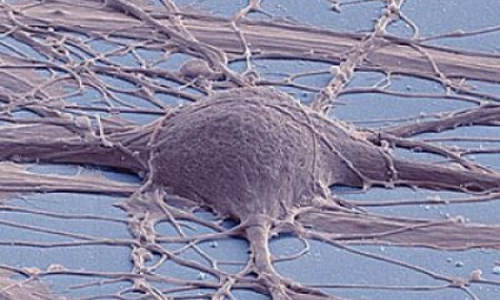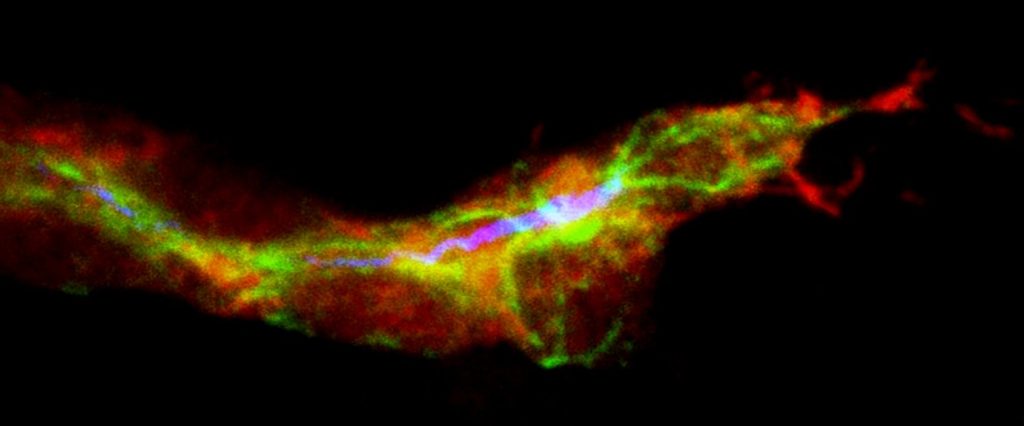A team of researchers from the University of California, San Diego School of Medicine, Oregon Health & Science University (OHSU) and Salk Institute for Biological Studies has shown for the first time that stem cells created using different methods produce differing cells. The findings, published in the July 2, 2014 online issue of Nature, provide new insights into the basic biology of stem cells and could ultimately lead to improved stem cell therapies.
This image depicts scanning electron micrograph of cultured human neuron from induced pluripotent stem cell. Photo Credit: Mark Ellisman and Thomas Deerinck, National Center for Microscopy and Imaging Research, UC San Diego
Capable of developing into any cell type, pluripotent stem cells offer great promise as the basis for emerging cell transplantation therapies that address a wide array of diseases and conditions, from diabetes and Alzheimer’s disease to cancer and spinal cord injuries. In theory, stem cells could be created and programmed to replace ailing or absent cells for every organ in the human body.
The gold standard is human embryonic stem cells (ES cells) cultured from discarded embryos generated by in vitro fertilization, but their use has long been limited by ethical and logistical considerations. Scientists have instead turned to two other methods to create stem cells: Somatic cell nuclear transfer (SCNT), in which genetic material from an adult cell is transferred into an empty egg cell, and induced pluripotent stem cells (iPS cells), in which adult cells are reverted back to a stem cell state by artificially turning on targeted genes.
Until now, no one had directly and closely compared the stem cells acquired using these two methods. The scientists found they produced measurably different results. “The nuclear transfer ES cells are much more similar to real ES cells than the iPS cells,” said co-senior author Louise Laurent, PhD, assistant professor in the Department of Reproductive Medicine at UC San Diego. “They are more completely reprogrammed and have fewer alterations in gene expression and DNA methylation levels that are attributable to the reprogramming process itself.”
The development and use of iPS cells has grown exponentially in recent years, in no small part due to the fact that they can be generated from adult cells (often from the skin) by temporarily turning on a combination of four genes to induce the adult cells to return to a pluripotent state.
Laurent noted that iPS cell lines have been created from patients to model many different diseases and “the ability to make personalized iPS cells from a patient that could be transplanted back into that patient has generated excitement because it would eliminate the need for immunosuppression.”
The nuclear transfer method has been pioneered more recently by a team led by Shoukhrat Mitalipov, PhD, professor and director of the Center for Embryonic Cell and Gene Therapy at OSHU. The technique is similar to the process used in cloning, but the pluripotent cells are collected from early embryos before they develop into mature organisms.
For their comparisons, the researchers at UC San Diego, OSHU and Salk created four nuclear transfer ES cell lines and seven iPS cell lines using the same skin cells as the source of donor genetic material, then compared them to two standard human ES lines. All 13 cell lines were shown to be pluripotent using a battery of standard tests.
But closer analyses employing powerful genomic techniques to examine the DNA methylation – a fundamental biochemical process that helps turn genes on and off – and gene expression signatures of each cell line revealed key differences in stem cells created with the three methods. Specifically, the scientists found that the DNA methylation and gene expression patterns in nuclear transfer ES cells more closely resembled those of ES cells than did iPS cells, which revealed alterations apparently caused by the reprogramming process itself.
“If you believe that gene expression and DNA methylation are important, which we do, then the closer you get to the patterns of embryonic stem cells, the better,” said co-senior author Joseph R. Ecker, PhD, professor and director of Salk’s Genomic Analysis Laboratory. “Right now, nuclear transfer cells look closer to the embryonic stem cells than do the iPS cells.”
“I think these results show that the SCNT method is a far superior candidate for cell replacement therapies,” said Mitalipov, also a co-senior author of the Nature paper. “I truly believe that using this method of producing stem cells will someday help us cure and treat a wide range of diseases that are defeating us today.”
While nuclear transfer cells may be a better and more accurate representation of human ES cells than iPS cells, Laurent said there are significant barriers to their wider adoption and application. “Not only is nuclear transfer technically difficult, but federal funds cannot be used in experiments involving this procedure.”
On the other hand, she said, the findings could spur improvements in iPS cell reprogramming methods. “Our results have shown that widely used iPS cell reprogramming methods make cells that are similar to standard ES cells in broad strokes, but there are important differences when you look really closely. By using the egg cell to do the job, we can get much closer to the real thing. If we can figure out what factors in the egg drive the reprogramming process, maybe we can design a better iPS cell reprogramming method.”
Story Source:
The above story is based on materials provided by University of California, San Diego Health Sciences





